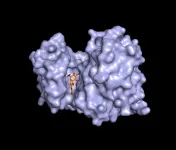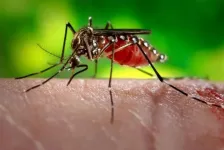Researchers learn that pregnant women pass along protective COVID antibodies to their babies
2021-02-22
(Press-News.org) Researchers Learn that Pregnant Women Pass Along Protective COVID Antibodies to their Babies
Antibodies that guard against COVID-19 can transfer from mothers to babies while in the womb, according to a new study from Weill Cornell Medicine and NewYork-Presbyterian researchers published in the American Journal of Obstetrics and Gynecology.
This discovery, published Jan. 22, adds to growing evidence that suggests that pregnant women who generate protective antibodies after contracting the coronavirus often convey some of that natural immunity to their fetuses. The findings also lend support to the idea that vaccinating mothers-to-be may also have benefits for their newborns.
"Since we can now say that the antibodies pregnant women make against COVID-19 have been shown to be passed down to their babies, we suspect that there's a good chance they could pass down the antibodies the body makes after being vaccinated as well," said Dr. Yawei Jenny Yang, an assistant professor of pathology and laboratory medicine at Weill Cornell Medicine and the study's senior author.
Dr. Yang and her team analyzed blood samples from 88 women who gave birth at NewYork-Presbyterian/Weill Cornell Medical Center between March and May 2020, a time when New York City was the global epicenter of the pandemic. All of the women had COVID-19 antibodies in their blood, indicating that they had contracted the virus at some point even though 58 percent of those women had no symptoms. Furthermore, while antibodies were detected in both symptomatic and asymptomatic women, the researchers observed that the concentration of antibodies was significantly higher in symptomatic women. They also found that the general pattern of antibody response was similar to the response seen in other patients, confirming that pregnant women have the same kind of immune response to the virus as the larger patient population--something that hadn't previously been known for sure, since a woman's immune system changes throughout pregnancy.
In addition, the vast majority of the babies born to these women--78 percent--had detectable antibodies in their umbilical cord blood. There was no evidence that any of the infants had been directly infected with the virus and all were COVID negative at the time of birth, further indicating that the antibodies had crossed the placenta--the organ that provides oxygen and nutrients to a growing baby during pregnancy--into the fetal bloodstream. Newborns with symptomatic mothers also had higher antibody levels than those whose mothers had no COVID symptoms.
This data implies that pregnant women could pass along vaccine-generated antibodies in the same way, potentially shielding both mother and child from future infection. However it is not yet known exactly how protective these antibodies might be, or how long that protection might last. Dr. Laura Riley, chair of the Department of Obstetrics and Gynecology at Weill Cornell Medicine, obstetrician and gynecologist-in-chief at NewYork-Presbyterian/Weill Cornell and one of the study's co-authors, is still advising pregnant patients who decide to get vaccinated to continue to follow current safety guidelines to prevent the spread of the disease. Dr. Riley, Dr. Yang and their colleagues are leading follow-up investigations that are currently enrolling pregnant women who receive the vaccine, as well as vaccinated mothers who are breastfeeding, to assess the antibody response in those groups after vaccination. That information could help guide maternal vaccination strategies moving forward.
"The $1 million question is: Will the group of women who are now being vaccinated get the same type of protection? We don't know that yet," Dr. Riley said. "Getting those answers is going to be really important."
INFORMATION:
ELSE PRESS RELEASES FROM THIS DATE:
2021-02-22
The U.S. pulp and paper industry uses large quantities of water to produce cellulose pulp from trees. The water leaving the pulping process contains a number of organic byproducts and inorganic chemicals. To reuse the water and the chemicals, paper mills rely on steam-fed evaporators that boil up the water and separate it from the chemicals.
Water separation by evaporators is effective but uses large amounts of energy. That's significant given that the United States currently is the world's second-largest producer of paper and paperboard. The country's approximately 100 paper mills are estimated to use about 0.2 quads (a quad is a quadrillion BTUs) of energy per year for water recycling, making it one of the most energy-intensive chemical processes. All industrial ...
2021-02-22
Large galaxies are known to strip the gas that occupies the space between the stars of smaller satellite galaxies.
In research published today, astronomers have discovered that these small satellite galaxies also contain less 'molecular' gas at their centres.
Molecular gas is found in giant clouds in the centres of galaxies and is the building material for new stars. Large galaxies are therefore stealing the material that their smaller counterparts need to form new stars.
Lead author Dr Adam Stevens is an astrophysicist based at UWA working for the International Centre for Radio Astronomy Research (ICRAR) and affiliated to the ARC Centre of Excellence in All Sky Astrophysics in 3 Dimensions (ASTRO 3D).
Dr Stevens ...
2021-02-22
FAYETTEVILLE, Ark. - Cold temperatures, prevalent during glacial periods, had a significant impact on past and modern unglaciated landscapes across much of North America, according to a recent study by University of Arkansas geologist Jill A. Marshall.
Marshall, assistant professor of geosciences, is the first author of the study, published in the journal Geophysical Research Letters.
The findings help shape understanding of the earth's "Critical Zone," the relatively thin layer of the planet that extends from where vegetation meets the atmosphere to the lowermost extent of weathered bedrock. "Climate and ecosystems determine how quickly bedrock ...
2021-02-22
DALLAS - Feb. 22, 2021 - Three decades-old antibiotics administered together can block a type of pain triggered by nerve damage in an animal model, UT Southwestern researchers report. The finding, published online today in PNAS, could offer an alternative to opioid-based painkillers, addictive prescription medications that are responsible for an epidemic of abuse in the U.S.
Over 100 million Americans are affected by chronic pain, and a quarter of these experience pain on a daily basis, a burden that costs an estimated $600 billion in lost wages and medical expenses ...
2021-02-22
Scientists have identified a way to "rescue" muscle cells that have genetically mutated, paving the way to a possible new treatment for rare childhood illness such as Duchenne Muscular Dystrophy (DMD).
The study, led by the Universities of Exeter and Nottingham, is published in the Proceedings of the National Academies of Sciences, USA. The research used novel drugs being developed at the University of Exeter, which "metabolically reprogram" the cellular energy production centres in muscle cells, by providing them with a fuel source to generate metabolic energy.
DMD is a genetic condition caused by a mutation in a gene called dystrophin which results in progressive irreversible muscular degeneration and weakening. Its symptoms include muscle ...
2021-02-22
Things just got hairy at Princeton.
Researchers found they could coat a liquid elastic on the outside of a disc and spin it to form useful, complex patterns. When spun just right, tiny spindles rise from the material as it cures. The spindles grow as the disc accelerates, forming a soft solid that resembles hairs.
Inspired by biological designs and rationalized with mathematical precision, the new method could be used at an industrial scale for production with plastics, glasses, metals and smart materials.
The researchers published their findings ...
2021-02-22
(Boston)--Tau is a protein that helps stabilize the internal skeleton of nerve cells (neurons) in the brain. Groups of toxic tau protein, termed tau oligomers, drive disease progression and memory loss in Alzheimer's disease (AD). A new study from Boston University School of Medicine (BUSM) shows how these tau oligomers form, and, correspondingly, how they can be prevented.
AD is a major cause of disease in the elderly and places a huge financial cost on the health care system. Scientists have known for a long time that two proteins (?-amyloid and tau) clump and accumulate in the brains ...
2021-02-22
LOGAN, UTAH, USA -- You might not like mosquitoes, but they like you, says Utah State University biologist Norah Saarman. And where you lead, they will follow.
In addition to annoying bites and buzzing, some mosquitoes carry harmful diseases. Aedes aegypti, the so-called Yellow Fever mosquito and the subject of a recent study by Saarman and colleagues, is the primary vector for transmission of viruses causing dengue fever, chikungunya and Zika, as well as yellow fever, in humans.
"Aedes aegypti is an invasive species to North America that's become widespread in the eastern United States," says Saarman, assistant professor in USU's Department of Biology and the USU Ecology Center, whose research focuses ...
2021-02-22
Adolescents and teens may be more likely to be bullied by their friends -- and friends-of-friends -- than classmates they don't know as well, according to a new study.
Diane Felmlee, Distinguished Professor of Sociology and Demography at Penn State and researcher on the paper, said the findings give new insight into how and why bullying occurs -- important information for anti-bullying efforts.
"People often assume that bullying occurs between relative strangers, or that it targets those on the fringes of the social network," Felmlee said. "Those do occur, but in our study, we find that the rate of peer aggression is significantly higher between those students who are closely linked. Furthermore, our finding is not due to friends simply spending ...
2021-02-22
In a new study out of University of California San Diego School of Medicine, researchers have identified a universal strain of bacteria derived from healthy human skin that can treat the most common type of eczema, also known as atopic dermatitis.
In the paper published Feb. 22, 2021, in Nature Medicine, the research team investigated the safety and mechanisms of this certain bacteria in a first-in-human, Phase I, double-blinded clinical trial looking to treat people living with eczema. Of the 54 participants, two-thirds reported improvements in their ...
LAST 30 PRESS RELEASES:
[Press-News.org] Researchers learn that pregnant women pass along protective COVID antibodies to their babies




